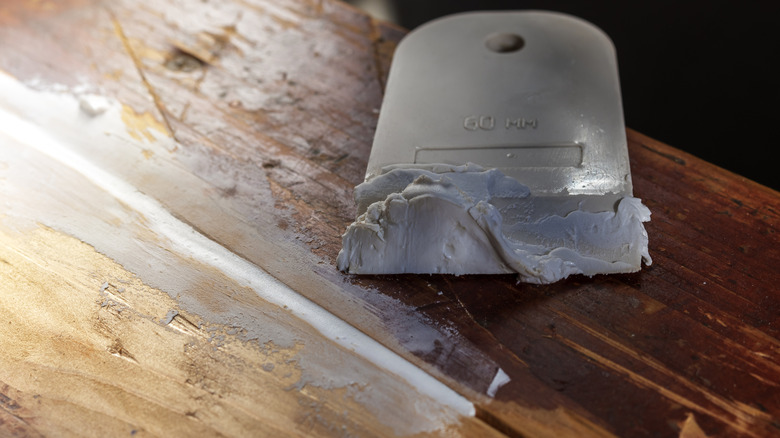The Two-Step Hack That Fixes Wood Cracks Without Filler
We may receive a commission on purchases made from links.
Are you an aspiring woodworker who loves to embark on DIY projects with scrap pieces of wood you have lying around? Maybe you were too heavy-handed when dusting and busted the corner of a prized picture frame, or perhaps your favorite dining chair is starting to look a little too beloved, thanks to small cracks and fissures starting to show up on the surface. A hack demonstrated on TikTok suggests alternating thin layers of superglue and sawdust to fix small surface issues such as these. But according to Bob Beacham, House Digest's expert carpenter and remodeler, although you can easily and quickly fill wood cracks without resorting to fancy fillers with this approach, he recommends using a combination of sawdust and wood glue instead.
"I know the hack. I've used it often," Beacham told House Digest in an exclusive interview. "However, I use wood glue. Although superglue also works, I have reservations about using it." Aside from the hidden downsides of using super glue to fix things around the house, like its flammable and toxic ingredients, Beacham said it just isn't forgiving enough because of how fast it sets. "It also doesn't stain particularly well (if you need to do that)." Instead, if you're going to try this hack, our carpentry expert recommended substituting a wood glue like Gorilla Water Resistant Wood Glue for superglue because it's harder to detect. "The big advantage of the wood glue and sawdust hack is that you can use the same wood to fill the damaged area, thus making it more or less invisible," Beacham added. "It will also absorb stain or wax at a very similar rate to the surrounding wood."
Apply a thick paste made of sawdust and wood glue to small cracks
During his exclusive interview with House Digest, Bob Beacham explained his preferred method for filling in cracks in wood surfaces step-by-step. "Take a scrap of wood and make some sawdust using reasonably fine-grit sandpaper," he said. The carpenter recommends using a paper like Arilier 240 Grit Sandpaper from Amazon, which will create very small particles that aren't discolored. Next, instead of alternating layers of glue and wood dust, he recommends mixing them on a piece of cardboard with a matchstick or pencil. "It should be mostly wood, with enough glue to bind it and produce a thick paste," Beacham said, adding that, depending on the consistency, your paste will remain workable for far longer than a thin layer of superglue applied directly to the crack.
You'll then need to thoroughly clean the cracked area to make sure there's no lingering dust or debris. Beacham suggests using a slightly dampened piece of kitchen paper towel. "This raises the grain a little (although you may not see it) and helps the filler bind," he explained. "Use a palette knife or similar to apply your filler to the crack." The carpentry expert said you'll need to firmly apply it without making the filler totally flat, since it will shrink as it cures. Finally, you'll sand and finish it. "Always use high-quality wood glue. Titebond III is my favorite."
Touch-up pens, crayons, and wood filler are better solutions for laminate, veneer, and larger projects
Despite this hack being a relatively quick, inexpensive, and effective method on real wood, Bob Beacham said there are some caveats you should be aware of before trying this two-step project in your workshop. "It's generally a method for solid wood, where you likely have offcuts handy to make the sawdust. It will work with plywood, too," he told House Digest during his exclusive interview. But when it comes to laminate or veneered surfaces, the carpentry expert said you'll have a hard time creating enough dust material for the hack to work. "You also have to be very careful not to go through those surfaces when sanding back the repair," he cautioned, adding that you'll get better results on laminate and veneer by using touch-up pens, crayons, and wax sticks.
"If I needed to repair multiple areas (refurbishing old furniture, for example), and an exact match wasn't important, I would probably go out and buy filler," Beacham said. "Commercially available wood fillers have guaranteed consistency." Along with appreciating their ease of use and fast-drying qualities, the carpentry expert explained that wood fillers are typically stainable or pre-colored to match popular types of wood. "If I'm going to be painting a piece, I invariably use bought wood filler. I would also use it on damaged edges or concerns because of its superior strength." If you go this route, make sure you understand the difference between wood putty and wood filler to ensure you pick the right product for your project.

